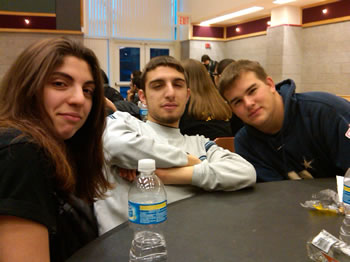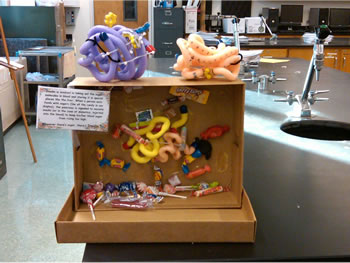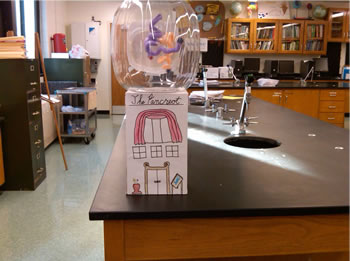Science Club Team Participates in Protein Challenge
 They didn’t come home with a trophy or a gold medal but some of Huntington High School’s best science students gained an awful lot at Stony Brook University’s Protein Challenge last week.
They didn’t come home with a trophy or a gold medal but some of Huntington High School’s best science students gained an awful lot at Stony Brook University’s Protein Challenge last week.
The Huntington contestants were “some of the brightest” members of the school’s science club, said Lori Pyzocha, a science teacher who serves as the club’s advisor. “Although the team did not place in the top three, the critical skills in building structural models of insulin and conducting testing on the topic of proteins turned out to be educational,” Ms. Pyzocha said.
 The Huntington team consisted of David Stillman, Sami Aiman, Adam Cerini, Emaad Khwada, Andrea Cerini, John Coffey, Andrew Ku, Mike O’Connor and Aryan Tefreshi.
The Huntington team consisted of David Stillman, Sami Aiman, Adam Cerini, Emaad Khwada, Andrea Cerini, John Coffey, Andrew Ku, Mike O’Connor and Aryan Tefreshi.
“The team was able to meet many other schools with members who are interested in the sciences while also having the opportunity to have lunch with scientists from OSI Pharmaceuticals and discuss career goals,” Ms. Pyzocha said. “Each year our team begins to strengthen and grow. It is a great environment for students to share their knowledge and love for the sciences.”
Participating teams were sent a kit containing a Mini-Toober for use in building a model on a scale of 2 cm/amino acid. “Students will represent other important parts of the protein, such as amino acid side chains, DNA or associated molecules, where applicable, with materials of their choosing,” according to the competition packet. “The additions to the Mini-Toober model should focus on illustrating the significance of the structure to the function of the protein. The models will be evaluated for accuracy. Students must provide a 3 x 5 note card explaining the creative additions to their model and what they represent.” The models were sent to Stony Brook a full week before the onsite competition.
 When the teams assembled on the college campus, they were required to build a model of a “selected region insulin or a related protein.” The teenagers were able to use a computer that was made available at the competition, with a Jmol application, a text editor, PDB file, structure summary page and “molecule of the month” files on it to guide in the model construction. “Students may only use one of the computers provided at the competition with the above-mentioned files on it to guide their model construction,” according to the competition rules. “Any model handed to the judges after the end of the competition time (50 minutes) will not be accepted for scoring.”
When the teams assembled on the college campus, they were required to build a model of a “selected region insulin or a related protein.” The teenagers were able to use a computer that was made available at the competition, with a Jmol application, a text editor, PDB file, structure summary page and “molecule of the month” files on it to guide in the model construction. “Students may only use one of the computers provided at the competition with the above-mentioned files on it to guide their model construction,” according to the competition rules. “Any model handed to the judges after the end of the competition time (50 minutes) will not be accepted for scoring.”
The competition also included a written exam about the relationship between protein structure and function with an emphasis on insulin.
Ms. Pyzocha, who also heads the high school science research program, has been indefatigable in lining up regional and national competitions for students and working with them to maximize their potential.
All graphics, photographs, and text appearing on the Huntington Public Schools home page and subsequent official web pages are protected by copyright. Redistribution or commercial use is prohibited without express written permission. Comments or Questions? email the Public Information Office